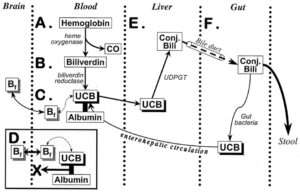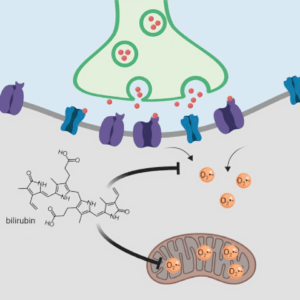Neonatal Kernicterus
Neonatal Kernicterus presents a grave concern for newborns as it arises from elevated levels of bilirubin in their bloodstream, leading to potential brain impairment as it reaches the brain. This condition commonly emerges as a complication of severe jaundice in infants.
What level of bilirubin causes kernicterus?
Realizing that solely basing the risk of kernicterus on a certain bilirubin level isn’t a good idea is crucial. While bilirubin levels give some clues, many factors make a person more or less prone. This complicates things.
Here’s what we can say about bilirubin levels in relation to kernicterus risk:
- Lower Levels: Bilirubin levels below 20 mg/dL are generally considered less risky for developing kernicterus, but this is not a definitive guarantee.
- Higher Levels: As bilirubin levels approach or exceed 25 mg/dL, the risk of kernicterus increases, and close monitoring and potential treatment become crucial. Levels above 30 mg/dL are considered extremely high risk.
Neonatal Kernicterus (Bilirubin Toxicity) stages
Kernicterus typically progresses through several stages, each with its own set of symptoms and complications:
- Early Stage: In the initial phase, levels of bilirubin start to increase, possibly without noticeable symptoms. Jaundice, the yellowing of the skin and eyes, might be the sole visible indication.
- Intermediate Stage: As bilirubin levels rise, it can lead to symptoms like reduced appetite, fatigue, and muscle rigidity. This phase may also bring about issues such as hearing impairment or seizures.
- Advanced Stage: In the advanced stage, severe neurological symptoms may occur, including muscle rigidity, arching of the back, high-pitched crying, and seizures. Brain damage becomes more pronounced, leading to long-term complications such as cerebral palsy and intellectual disabilities.
Mechanisms of Brain Damage in Kernicterus

- Bilirubin Toxicity: High levels of bilirubin can hurt brain cells. They mess up the regular work of brain cells. That can cause harm and poor performance.
- Bilirubin Binding to Brain Tissues: Bilirubin can latch onto brain proteins and structures. This creates problems, messing with how they work and leading to cell damage. This binding can mess up the release of neurotransmitters, mess up the transmission at the synapses, and cause issues with cell metabolism.
- Inflammation and Oxidative Stress: Too much bilirubin in the brain can cause swelling and stress. This can add to nerve damage. Inflammation and stress can make the harmful effects of bilirubin worse, leading to more brain damage in kernicterus.
- Disruption of Brain Development: Kernicterus might happen when baby brains mature, mostly in newborns and tiny infants. Brain harm from bilirubin at these key times can cause long-term change in brain growth, causing issues in thinking and movement.
What level of bilirubin needs treatment?

When bilirubin levels exceed 20 milligrams per deciliter (mg/dL) in newborns, it often signals the need for medical intervention. Nonetheless, this threshold can vary depending on factors like the infant’s age, general well-being, and jaundice risk. Healthcare professionals must diligently monitor bilirubin levels and recommend appropriate treatment if they surpass the recommended thresholds to avert complications like kernicterus.
Pathophysiology of Neonatal Kernicterus (Bilirubin Toxicity)
Bilirubin is a yellow pigment. It’s usually created when your body recycles old red blood cells. The liver’s job is to handle bilirubin and remove it. But sometimes, there’s too much bilirubin in your bloodstream. This excess can reach your brain. It can then damage your brain cells. We call this harmful situation Kernicterus. But sometimes, like during bad jaundice, the liver can’t manage too much bilirubin. This makes it pile up in the blood.
kernicterus long-term effects

Kernicterus emerges as a severe condition impacting newborns due to elevated levels of bilirubin in their bloodstream. This elevation poses a threat to brain cells, potentially resulting in enduring difficulties. The extent of the condition’s impact varies significantly among individuals, with a spectrum of lasting consequences that may ensue.
Movement Problems:
- Cerebral palsy: This condition affects muscle tone, movement, coordination, and posture. It can manifest in various ways, impacting an individual’s ability to walk, talk, and perform daily activities.
- Involuntary movements: These can include tremors, stiffness, or uncontrollable jerking movements.
Hearing Loss:
- This is the most common long-term effect of kernicterus, ranging from mild to severe hearing impairment. It can affect communication, learning, and social interaction.
Learning Disabilities:
- Difficulty may arise with memory, attention, problem-solving, and communication skills. The specific nature and severity of these difficulties can vary based on the affected areas of the brain due to kernicterus.
Vision Problems:
- Gaze palsies, where individuals have difficulty controlling eye movements, or other visual impairments can be present.
Dental Issues:
- Enamel dysplasia, characterized by discolored or weakened teeth, might be present in some cases.
What are the effects of kernicterus on the brain?
Kernicterus can have significant effects on the brain, particularly in newborn babies. Here’s how it can impact brain function:
Neurological Impairments:
Kernicterus might cause brain harm. It impacts parts of the brain that handle movement, coordination, and sense processing. This harm can trigger serious, long-lasting issues. These include cerebral palsy, growth lag, and struggle in learning.
Cognitive Function:
Kernicterus, a cause of brain damage, could also mess with thinking abilities like memory, focus, and solving problems. This can show up as trouble learning, grasping, and working out information.
Motor Disorders:
Kernicterus leads to stiff muscles and tough movements, often named motor disorders. This can limit a person’s daily tasks like walking, using hands, or being independent.
Hearing Loss:
Kernicterus can cause some people to have sensorineural hearing loss. This makes hearing sounds hard. It can affect talking, socializing, and life’s quality.
Seizures:
When kernicterus gets really bad, a person might start having seizures. This happens because the electricity in their brain acts weird. If these seizures keep happening, they can make the brain damage worse and might cause serious brain problems down the road.
How do neonates with kernicterus have hearing loss?
Neonatal Kernicterus causes hearing loss in neonates in several ways that are:
- Bilirubin Buildup: In babies suffering from kernicterus, too much bilirubin can pile up in the blood and get into the brain. Upon contacting the inner ear’s fragile tissues or the auditory nerve, it might harm these sensitive areas.
- Harm to Hearing Parts: Too much bilirubin can hurt the hearing nerve, cochlea, or other parts inside the ear that send sound signals to the brain. This harm can mess with the usual way of handling sound and cause lost hearing.
- Sensorineural Hearing Loss: Hearing loss linked to Kernicterus is typically sensorineural. This means the inner ear or hearing nerve suffers damage. Sadly, this kind of hearing loss is lasting and treatment won’t undo it.
- Impact on Communication: Kernicterus in newborns can lead to hearing loss. This creates difficulty in hearing things crisp and clear. Speech and general sounds might be affected. This can make chats and understanding language tough, which can impact social ties and life quality.
